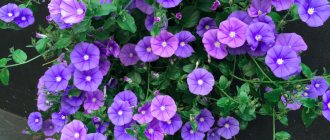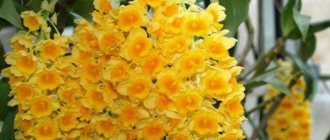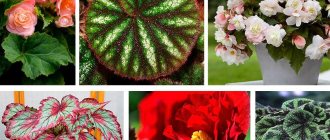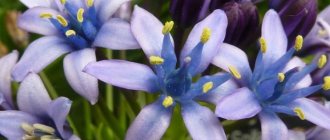The climbing flowering plant Mandevilla, or Dipladenia, is part of the Kutrovaceae family. Under natural conditions, such a plant can be found in Central and South America. According to various sources, this genus includes 120–190 species, among which there are both annuals and perennials. Many gardeners also call indoor greenhouse and garden mandevilla jasmine, or Brazilian balsam, or Chilean jasmine, or Bolivian rose, or Mexican tree of love. This genus received its scientific name "Mandevilla" in honor of Henry J. Mandeville, who was an English diplomat and amateur gardener while serving in Argentina. Translated from Greek, “dipladenia” means “having double glands.” Indoor dipladenia is a very impressive plant, which is distinguished by its capriciousness and high demands on growing conditions and care. However, it is still becoming more and more popular with flower growers every year.
Brief description of cultivation
- Bloom . Lush and long-lasting (from the last days of March to November).
- Illumination . Needs bright but diffused light. It is recommended to place it on a windowsill with a western or eastern orientation.
- Temperature regime . During the growing season - from 18 to 26 degrees, and during the dormant period - from 12 to 15 degrees.
- Watering . It should be plentiful with a frequency of two or three times a week. The soil mixture in the pot is moistened only after its surface has dried to a depth of 10 to 15 mm. On very hot days, the bushes are sometimes watered twice a day. Starting in September, a gradual reduction in watering is carried out.
- Air humidity . Should be elevated. To do this, the flower is kept in a special glass display case, or the pot with the plant is placed on a tray filled with wet pebbles.
- Fertilizers . Feeding begins in March, from this time liquid nitrogen fertilizers are added to the substrate once every 7 days. However, with the beginning of the formation of buds, the flower should be fed with potassium-phosphorus complex fertilizer, which is applied systematically once a week until August.
- Trimming . It is carried out systematically in the autumn, immediately after the end of the growing season.
- Transplant . If necessary, after the root system of the bush becomes very crowded in the flower pot. Adult bushes are not replanted; instead, the top layer of soil mixture in the pot is regularly replaced.
- Reproduction . By cuttings and seed method.
- Harmful insects . Whiteflies, mealybugs and spider mites.
- Diseases . Powdery mildew.
Transfer rules
Growing a plant in a greenhouse
Adult specimens need to be replanted once every 2 years. Humus must first be added to the soil. During the procedure, the soil is renewed, the plant consumes all the necessary substances from the soil and grows green mass faster.
At home, you can prepare a sand mixture, which will have a slightly acidic reaction and consist of:
- turf and leaf soil
- humus
- coarse sand
- peat
The sand must be coarse-grained to ensure better aeration.
Transplantation is carried out in the spring. To avoid damaging the root system when removing the plant from the ground, first thoroughly water the earthen ball and then carefully remove it from the pot. If the cuttings of a plant accidentally break off during replanting, it doesn’t matter, you can root them and get new specimens to replenish your collection.
A layer of drainage must be placed at the bottom of the containers. It is recommended to constantly loosen the soil after watering.
Features of dipladenia
Mandevilla is a lush evergreen vine that grows rapidly. The stem is climbing, woody, it is decorated with oppositely arranged rich green leaf plates, they are glossy, leathery, oval in shape to the touch. If you break a leaf, milky juice will ooze from it, which is poisonous.
In indoor conditions, dipladenia is cultivated as a climbing plant or compact bush. The fragrant funnel-shaped flowers consist of 5 petals, which can be pink, red, white or crimson. On an adult bush, up to 80 flowers can open at the same time, and they will delight you with their beauty for more than a week.
MANDEVILLA OR DIPLADENIYA CARE SECRETS AND TRANSPLANTATION | ONLY PERSONAL EXPERIENCE
Mandevilla care at home
Illumination
In order for indoor mandevilla to grow and develop well, it needs to be provided with conditions that are very similar to natural ones. As for lighting, the vine needs a lot of bright light, otherwise it will not be able to reach the peak of its attractiveness. This flower grows best on windows with a western or eastern orientation. The bush can also be placed on a southern windowsill, but in this case it will have to be shaded during the midday hours from direct sunlight, because they can damage the foliage.
Temperature
In winter, dipladeniya should be kept cool (from 12 to 15 degrees), and in summer it is moved to a warmer place (from 18 to 26 degrees). However, if the room in the summer is warmer than 26 degrees, the plant will not suffer from this; on the contrary, the color of the flowers will become more saturated and bright.
The liana needs fresh air, so the room where it grows will have to be ventilated very often. But do not forget to protect the flower from drafts, as they can destroy it. In the summer, if possible, it is transferred to the veranda, balcony or garden, and choose a place that is protected from drafts, direct rays of the sun and wind.
Trimming and garter
Since mandevilla is a climbing plant, when growing at home, do not forget to tie it up in a timely manner, as well as prune it. The height of the support should be 1.5 times the size of an adult bush. Its stems will climb the support and gradually take over it completely.
Watering
Like other plants that come from the tropics, mandeville needs timely, abundant watering. It is necessary to moisten the substrate in the container only when it dries 10–15 mm deep. For irrigation, which is carried out on average twice or thrice a week, exclusively warm water is used. During hot, dry periods, you have to water the vine once or twice a day. In September, the quantity and abundance of watering begins to be gradually reduced, but make sure that the vine does not begin to fly off its leaves due to lack of water.
Remember that this crop reacts extremely negatively to lime. In this regard, the water with which the flower is watered must be settled (at least 24 hours) or filtered. Once every 30 days, add enough fresh lemon juice or citric acid to the water intended for irrigation so that it tastes slightly sour.
Air humidity
The plant needs high air humidity at any time of the year. In this regard, it is recommended to grow it in a special glass display case. If you do not have the opportunity to place the flower in the display case, then small wet pebbles are poured into the tray, and the pot is placed on it. You can also place the container with the vine in a large flowerpot. After this, all the free space between the walls of the pot and the pot is covered with damp sphagnum moss or peat.
To increase air humidity, you can spray the foliage with warm water every day. This procedure is especially recommended for the flower during flowering and bud formation.
Top dressing
When growing such a flower, do not forget to feed it in a timely manner. In order for the vine to be decorated with spectacular leathery leaves, it must be fed with fertilizers containing nitrogen. However, immediately after buds begin to appear on the bush, and even during flowering, it is fed with phosphorus-potassium fertilizers. For fertilizing, liquid fertilizer is used, and it should be added to the substrate regularly once every 7 days, but not all year round, but from March to August. In winter, the liana does not need feeding.
Dipladenia transplant
Mandevilla grows best in a loose, moderately acidic substrate rich in nutrients. A soil mixture consisting of sand, peat, humus, leaf and turf soil is well suited, and they are taken in equal parts. Instead of sand, you can take fine perlite or expanded clay, thanks to them the soil mixture becomes looser, as a result of which the root system of the bush can receive a sufficient amount of oxygen.
Transplantation is carried out only when necessary, or rather, after the root system becomes very crowded in the container. To do this, inspect the drainage holes at the bottom of the pot; if the roots are peeking out of them, then the mandevilla must be replanted. When the vine becomes an adult, it is better not to replant it; instead, systematically replace the top layer of soil mixture in the pot with a new one.
Trimming
This flower is fast growing and therefore needs regular pruning. If you don’t do this, the bush will grow very quickly, and after a while you will have a real jungle in your apartment. The formation of buds occurs on the stems of the current year of growth. In this regard, in the autumn, the vine must be pruned at the very end of the growing season. Unbranched old stems are shortened by 2/3, and branched shoots are shortened by 1/3 or ½ of the length after forking. As a result, after pruning, only 1/3 of the unbranched shoot should remain, and the third part of the branched shoot should remain after the fork. If the plant is pruned correctly in the fall, it will survive the winter well and will actively grow young stems during the next growing season.
Wintering
The dormant period of Dipladenia begins in late autumn and ends in early spring. During this period, the vine should be in a room in which it should not be colder than 12 degrees and not warmer than 16 degrees. After the bush is pruned in the fall, a sharp reduction in watering is carried out. During the dormant period, it is watered only after three days have passed after the substrate in the container has completely dried.
In the spring, when the mandevilla begins to awaken, it is moved to its usual place, after which the usual summer watering regime is gradually resumed. From this time on, fertilizers begin to be added to the soil mixture.
Dipladenia - proper care during the flowering period
Table: typical problems when growing plants, their causes and solutions
| What does the plant look like? | What is the reason | How to fix the situation |
| the plant sheds buds and leaves |
|
|
| not enough light |
|
| The plant is withering | lack of watering |
|
| Leaf blades turn yellow and fall off | the plant is too hot |
|
Reproduction methods
Growing from seeds
An adult dipladenia has a fairly high price in a flower shop, so it may not be affordable for every gardener. But if you really want to decorate your home with such a vine and are not afraid of possible difficulties, then try to grow it from seeds, and seed material of various varieties of mandevilla is available for sale.
Take a container with holes at the bottom for drainage and fill it with a slightly acidic, light and loose soil mixture, into which the seeds are sown. The crops are transferred to a well-lit (the light should be diffused) and warm (from 22 to 28 degrees) place, and they are provided with regular watering, while making sure that the substrate is always a little damp, but do not allow liquid to stagnate in it.
You will have to wait a very long time for the first shoots, about 2–4 months, and throughout this time you will need to systematically water the crops and also remove condensation from the surface of the shelter. After the emerging seedlings have formed 2 true leaf plates, they are picked into individual cups that have holes at the bottom for drainage, and the substrate is used the same as for sowing. After some time, when the bushes grow, they are transplanted into permanent containers.
Cuttings
From the second half of spring to mid-summer, the vine can be propagated by cuttings. The upper parts of young stems are taken as cuttings in spring, and sections of lignified mature shoots are taken in summer. When working with dipladenia, remember that its shoots and foliage contain juice that contains poison, so do not forget about precautions: protect your hands with rubberized gloves and do not allow the juice to come into contact with mucous membranes and skin.
For rooting, the cuttings are planted in small cups, which are filled with a moistened substrate, which includes peat and sand (1:1). Also, if desired, you can pour one part of dry sphagnum into it. When planting for rooting, the cuttings must be deepened to the first pair of leaf blades. Then it is put into a mini-greenhouse, where it should always be very warm (no colder than 25 degrees). Bottom watering (through a tray) is recommended for cuttings. Most often, after 30 days, the cuttings grow their own root system, and when this happens, they are planted in permanent pots. There are cases when gardeners root Dipladenia cuttings in a glass of water. And when they grow roots 10–20 mm long, they are planted in pots filled with soil mixture.
If everything is done correctly, the cuttings should easily take root. But there are times when terry mandevilla cuttings do not want to take root. In this case, the solution will be to grow terry varieties from seeds.
Dipladenia - propagation by cuttings
Pruning mondevilla in spring
Rejuvenated Mandevilla grows more vigorously and should be pruned regularly. This procedure is recommended to be carried out once a year, preferably in early spring.
Dipladenia is a climbing plant, so keep it either in hanging pots, or organize supports for weaving mustaches
Tip #2. When pruning Dipladenia and other manipulations with it, it is strongly recommended to use disposable gloves. And after finishing work, wash your hands thoroughly, as the white juice of Dipladenia irritates the skin. More sensitive skin may experience burns and ulcers.
Diseases and pests
Possible problems
If the mandevilla is not properly cared for or kept in unsuitable conditions, various problems may arise, for example:
- Yellowing of foliage . If the foliage on the bush turns yellow in the warm season, this means that the air humidity in the room is very low. And if yellowing is observed in winter, this may be due to the fact that the room is too cold. Also, yellowing leaves may be a sign of the presence of pests on the vine or its damage by disease.
- Flying leaves . The leaves of such a plant turn yellow and then fall off due to the fact that the room is very cold or the bush is not watered correctly (lack of water or its stagnation in the substrate).
Harmful insects
As a rule, harmful insects settle on those bushes that are weakened by poor care, for example:
- unsuitable water is used for irrigation;
- the substrate used to grow the flower is infected with fungi or pest larvae:
- the plant does not have enough light or is too cold;
- Dust is not removed from the foliage in a timely manner.
As a rule, all these violations most often cause whiteflies, mealybugs or spider mites to settle on the vine. Most often, whiteflies settle on those bushes that are outdoors in the summer. In this regard, when you move the bush back into the house in the fall, carry out a mandatory inspection of its foliage. The fact is that it is on the underside of the leaf blades that whiteflies, which are similar in appearance to a small moth, prefer to hide. If you see pests on a vine, then it must be sprayed with an insecticide (Aktara, Aktellik or Fitoverm), otherwise, after the mandevilla is in the house, the pests will quickly move to other indoor plants.
Mealybugs are sucking pests that make punctures in stems and foliage and suck out the sap from them. This pest is also considered one of the main carriers of viral diseases. You can understand that a bush is affected by scale insects by the following signs: the foliage loses its turgor, the bush becomes lethargic, the buds are deformed, and insects similar to small mosquitoes fly around the plant. Also, lumpy formations appear on the surface of the substrate in the pot, and on the flower itself you can see small white oval-shaped bugs. To get rid of scale insects, the plant can be sprayed with garlic infusion, for the preparation of which a head of garlic is passed through a press and then combined with 1 tbsp. just boiled water. The infusion will be ready in four hours, then it is used to wash those areas of the bush that are affected by the pest. If necessary, the following chemicals can be used to control the pest: Aplaud, Phosfamide and Bi-58.
The greatest danger to the plant are spider mites, which are arachnids. Their appearance on the bush is facilitated by dry air in the room. If black or brown dots form on the foliage, then conduct a thorough inspection of the plant, paying special attention to the underside of the foliage, since this is where ticks prefer to hide. The presence of a pest is also indicated by the thinnest web found on the vine. Wipe the foliage of the plant with slightly sour water in which a little soap is dissolved. If this method turns out to be ineffective in controlling the pest, then the bush is sprayed with an acaricide solution, for example, Fitoverm. Increasing the level of air humidity in the room also helps to cope with the pest.
Diseases
Of all the diseases, the greatest danger to dipladenia is powdery mildew. The affected bush develops a whitish coating on the surface of all above-ground parts. In order to save a sick flower from this fungal disease, it is treated with a solution of colloidal sulfur (1%). To do this, the product is applied to all affected areas of the plant, and after 24 hours it must be washed, giving it a warm shower. Most often, in order to completely defeat the disease, the flower has to be treated twice or three times.
Possible problems
Consequences of improper winter care for dipladenia:
- At low temperatures and insufficient humidity in the room, the leaves of the flower darken and crumble.
- If the lighting in the room is dim and insufficient, this may result in a lack of flowering.
- Abundant watering has a detrimental effect on the root system, because... it may rot.
- The leaves curl when exposed to bright sunlight.
- If there is insufficient fertilizing, the flower will not bloom for a long time.
The end of winter is the time when dipladenia emerges from the dormant state and enters the active period. First of all, it is advisable to place the plant in a sunny and warm place. It is also necessary to gradually resume watering and apply fertilizers. When the temperature becomes consistently warm, dipladenia can be moved to the balcony or yard.
Types of dipladenia with photos and names
Not too many types of mandevilla are grown by gardeners indoors. Below we will describe those that are most popular in culture.
Dipladenia splendens
This species is a climbing evergreen plant, cultivated by gardeners most often as an hanging plant. While the shoots are young, there is pubescence on their surface, and they are decorated with lush oval-shaped foliage, which reaches about 20 centimeters in length, and has a heart-shaped base and a pointed apex. As the stems grow (they can reach 4–5 m in length), they become exposed, and the amount of foliage on them gradually decreases. During flowering, loose clusters are formed, consisting of 6 flowers, white on the inside and deep pink on the outside, which reach about 100 mm in diameter. The bracts are purple.
Bolivian Dipladenia bolewiensis
This heat-loving species comes from Bolivia, and it is most popular among gardeners. And they fell in love with it for its long stems, which are decorated with rich green ovoid leaf plates, reaching 50–80 mm in diameter. The racemose inflorescence is formed on axillary peduncles, and it consists of three or four white flowers, reaching up to 50 mm in diameter. The throat of the flowers is yellow, the tube is cylindrical in shape, and there is also a saucer-shaped bend.
Dipladenia eximia
This evergreen vine has smooth shoots that are pale red in color, and they are decorated with rich green, round-ovate leaves that reach 30–40 mm in length. The racemose inflorescences consist of 8 flowers, reaching up to 70 mm in diameter, their tube length is about 50 mm, the calyx is red, and the corolla is usually pinkish-red.
Dipladenia sanderi
Thick oval-shaped leaf plates with a slightly pointed upper part grow on smooth shoots, the length of which reaches 50 mm and even more. During flowering, axillary brushes appear, which include from 3 to 5 rich pink flowers, reaching up to 70 mm in diameter, their throat is yellow.
Dipladenia laxa
This highly branching species can grow very large in indoor conditions, so it requires a lot of space. The warty shoots can be about 5 meters long; they grow opposite leaf plates of an emerald green hue and an oblong-ovate shape. The front surface of the foliage is smooth, but the back surface has pubescence; it can reach about 10 centimeters in length. The inflorescences include from 5 to 10 corrugated flowers of a creamy white hue, which have a diameter of about 90 mm.
The most popular of all mandevilla varieties are the following:
- Allamandou . This plant is distinguished by its unpretentiousness and large, rich yellow flowers.
- Cosmos White, Fair Lady and Summer Snow . These varieties bloom long and luxuriantly with snow-white flowers.
- Pink Parfait . The plant is decorated with fragrant multi-petaled flowers. The variety is also called “Thai rose”.
- Red hood . The flowers are cherry pink.
- Scarlet Pimpernel . In the sun, the flowers of such a vine can shimmer in all possible shades of red.
- Yellow . The flowers of this variety shine with gold.
- Cosmos Rose . The bush is decorated with fleecy large flowers.
- Classic Ed . This large vine has deep red flowers.
- Laksa , or Chilean Jasmine . This Argentinean variety is distinguished by the sharp scent of gardenia.
- San Parasol Crimson . The petals of the flowers are pointed, like those of fragrant tobacco.
Mandevilla (Dipladenia) is an amazingly beautiful flower. Care, propagation.
The soil
The soil for dipladenia should be fertile, moderately acidic and loose - well permeable to water and air. It is also important to have a good drainage layer so that the water in the pot does not stagnate.
The optimal composition of soil for dipladenia:
- Sod land - 2 parts;
- Leaf soil - 1 part;
- Humus – 1 part;
- Sand – 1 part.
Before planting, the mixture should be sterilized to avoid infecting the vulnerable Dipladenia with root pests.
You can add 1 part of peat to the specified mixture to acidify the soil and increase its looseness. But there should not be a lot of peat in the soil mixture. This component is capable of retaining water at the bottom of the pot, which sometimes leads to rotting of the roots.
Instead of sand, other disintegrants are used: perlite, vermiculite and brick chips. These materials provide oxygen access to the roots of the vine.











